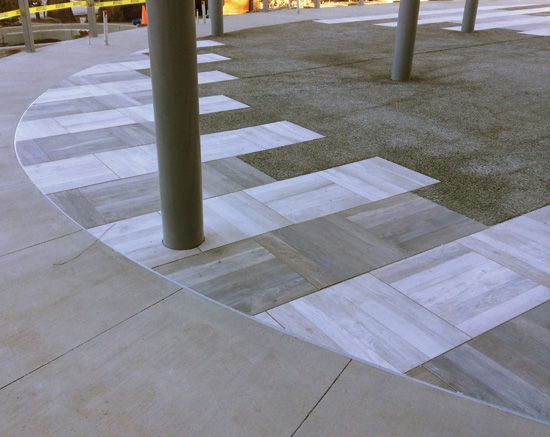A New Option in Exterior Paving
With this system, single slab structural porcelain pavers are laid with each corner of the pavers placed on the head of adjustable height pedestals. Inbuilt spacer tabs on the pedestal head keep the pavers accurately aligned. As previously described, a pedestal system can be used to raise the deck height from as little as ½ inch to over 3 feet if necessary, without any permanent structures being installed on the rooftop, since the pedestals simply sit on the existing surface or waterproof membrane. Because porcelain pavers are available in a variety of visual effects and textures, including wood, they afford the opportunity to create a “wood look” deck in locations which may have strict fire codes that prohibit or restrict the construction of a natural wood deck.
In addition to lowering roof temperatures due to the thermal break between pavers and roof surface, at the other end of the temperature scale, a heating system can be placed under the tiles to enable snowmelt, typically piping an ethylene glycol solution through a panel containing turbulating flow channels.

Photo by J J Albanese
Proper installation procedures are required for best results with porcelain pavers.
Installation of Elevated Deck Systems
There are several standard basic requirements for proper installation of elevated deck systems.
• The substrate under the pedestals should provide for positive drainage.
• The substrate on which the pedestals are to be placed must be well compacted (if on grade) and structurally capable of supporting the anticipated loading.
• Where elevated decks are installed over roofing substrates, roof systems must comply with all local building codes.
• Decks must be designed not to exceed the load capacity of the pedestals or the pavers.
• All assemblies of pedestals and pavers must be restrained on all sides of the paved area. Any area of a deck that is not restrained by a parapet or boundary wall must be boxed in and fully contained so that the pavers cannot move.
• There should be no movement greater than 3/16 inches between the outside edge of the pavers and the perimeter walls of the deck system.
• Any parapet, wall, concrete divider or other perimeter restraint must be capable of resisting lateral forces sufficient to the move the paver and pedestal system.
• For roof decks over waterproofing membranes, pedestals may normally be installed directly on top of high density closed cell extruded 60 psi polystyrene insulation.
• Pedestals should not be installed over any insulation with a density of less than 20 psi or with low density polystyrene, or bead board insulation.
• Elevated deck systems with porcelain pavers and pedestal supports are designed for pedestrian traffic only. Neither the pavers nor pedestal system are designed for supporting decks carrying motorized vehicles or heavy equipment.
Preparation
Adequate preparation includes the following.
• Before any work commences, all elevations and deck dimensions should be checked and verified, the presence of appropriate perimeter containment should be confirmed, and the substrate checked to ensure it is in a satisfactory condition for placement of the pedestals.
• If being used, waterproofing installation should be examined, particularly where it is flashed against vertical surfaces and horizontal waterproofing, and any surface defect which may impair performance of the pedestals or waterproofing membrane repaired.
• The surface on which the pedestals are to be placed should be clean and free of debris or projections that could affect the correct installation of the pedestals.
• All pavers should be inspected for chips or cracks which exceed specified tolerances, and for conformance to the specified color range.
• Pavers from different pallets should be mixed to produce a visually appealing blend of colors and textures,
• After the starting point and finishing point of the deck surface have been determined, the elevation of the top surface of the pedestal head should be established and marked around the perimeter using a transit water level or laser leveling device. Care should also be taken to mark off and square the perimeter with control lines.
• Good practice also includes marking out grid lines in both directions across the deck area and mark the location of each pedestal.
Laying Pedestals and Pavers
For the first row of pavers, installers should place a pedestal where each grid line meets the perimeter, and remove two spacer tabs in line with each other from the head of each pedestal located along the perimeter. All four spacer tabs should be removed from pedestals placed at the corners of the deck.
Pedestals should be positioned as close to the perimeter wall as possible. A section of the pedestal base may be cut off per the pedestal manufacturer’s instructions to ensure closer proximity to the perimeter wall.
The height of each pedestal should be set so that the top of the pedestal head is level with the elevation marked around the perimeter.
Installers should commence laying the pavers by placing each corner of the paver on the pedestal head, ensuring the pavers butt tightly against the spacer tabs.
In high traffic or high load situations or if recommended by the paver manufacturer, an extra pedestal may be placed in the center of each paver. In this case, all tabs should be removed from the pedestal head and the pedestal screwed so that it is firmly in contact with the underside of the paver.
Any slight irregularities in paver thickness can be compensated by using shim segments. While a small quantity of adhesive may be used to fix shims in place on the pedestal head, unless otherwise specified, construction adhesive should not be used to adhere pedestals or shims to insulation, waterproofing membranes or the roof surface.
As each row of pavers is laid, the head or coupler of the pedestals should be screwed up or down to ensure the surface of each paver is perfectly level either by rotating the screwed column or by use of a height adjustment tool inserted in the head of the pedestal, . On large decks, it is recommended to pre-sort and pre-set heights of pedestals to the correct elevation and place them into position prior to installing the pavers. Frequent inspection during installation will assure grid lines are maintained in a straight and consistent pattern and that pavers are level and not rocking.
Where the height of the deck does not permit the use of adjustable height pedestals (less than about 1 ¼ inch pedestal height), stackable fixed height (typically 1/2 or ¾ inch ) support pads can be used. These plastic or rubber pads are also used where a deck installation is to commence at the minimum height possible and progress to higher elevations using adjustable height pedestals. Not more than four fixed height supports should be stacked together.
It is advisable to use shims on top of the plastic fixed height support pads to provide added sound and shock absorption but this is not necessary with the rubber pads . Spacer tabs can be cut or snapped off to accommodate perimeter and corner support locations.
Post Installation
After installation, the deck should be carefully inspected to achieve consistency with the following:
• The spacing between pavers and at the perimeter wall does not exceed 3/16 inch, unless otherwise specified.
• Particular attention should be paid to ensure the edges of pavers installed at pedestrian access points are not raised which could create a tripping hazard.
• All required spacer tabs should be in place and visible.
• There should be no rocking of the pavers with foot traffic.
Porcelain Pavers and Pedestal Systems: A Winning Combination
New to the US market, structural porcelain pavers combined with pedestal systems make for an attractive, durable surface for elevated decks on rooftops and general paving for commercial and public spaces. For a cost effective alternative to traditional pavers that is scratch, stain and slip resistant, frost and fire proof, high in load bearing capacity yet low in weight, architects have a valuable addition to their toolbox with structural porcelain pavers.
 |
HandyDeck supplies structural porcelain pavers and pedestal systems for constructing elevated decks on rooftops, over sloping surfaces or directly over existing concrete, offering an elegant, stain resistant, frost resistant, low maintenance alternative to concrete pavers. www.handydeck.com |








